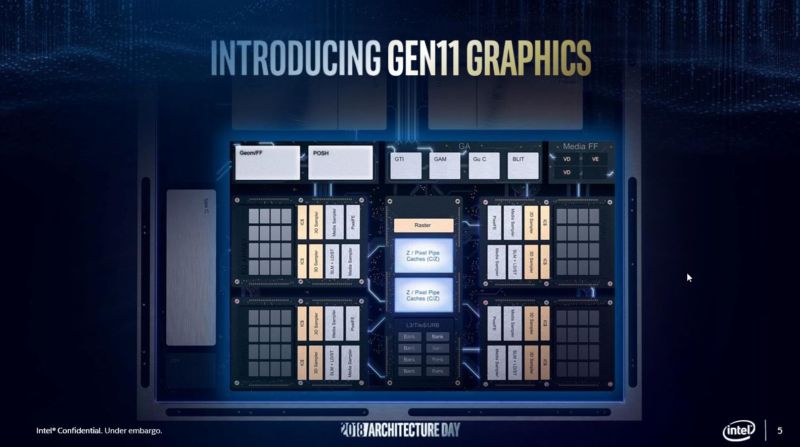INTEL

Company promises big boost to integrated GPU, breaks teraflop barrier Intel is promising a huge improvement over the performance of its integrated GPUs. Its generation 11 ("Gen11") GPU will more than double the execution units from (usually) 24 to 64, and in doing so boost the number-crunching performance to more than 1 trillion floating point operations per second.
Just as the current Gen9 GPUs, Gen11 is arranged into blocks combining execution units (EUs) with dedicated 3D hardware such as texture samplers. Gen9 parts have up to 8 EUs per block, and the most common configuration found in Intel's processors, GT2, has three such blocks for a total of 24 EUs (though there are designs with six or nine blocks, for 48 or 72 EUs). Gen11 has 16 EUs per block and will have configurations with four blocks. It's all these extra execution units that enable that headlining 1TFLOPS performance figure.
The new GPU will use a tile-based rendering approach, which divides the image into tiles that are all rendered separately. This tends to reduce the amount of memory bandwidth the GPU needs, which is valuable in integrated GPUs, as they lack the high-performance memory found in discrete parts. The Mali GPUs designed by ARM, along with Qualcomm's Adreno GPUs, both use tile-based rendering, too.
The chip will contain the usual block of dedicated encoders and decoders for motion video. It will have two decoders and one encoder, with Intel saying that it has redesigned its HEVC / H.265 encoder from the ground up. This will support 4K and even 8K streams. The GPU supports HDR screens and also Adaptive Sync technology. Adaptive Sync is the name given to the "standardized" version of what AMD calls FreeSync. Adaptive Sync enables variable refresh rates over DisplayPort, so the refresh rate can match the frame rate the GPU is producing.
The result of all this extra GPU power? It should shift the healthy number of games from the "too slow to playable" into the "playable" category. Intel has demonstrated Tekken to show this off; at medium graphics and 1080p, the game was actually playable on Gen11 but remained a slow jerky mess on Gen9.
The new GPU will ship in 10nm processors available in 2019, so it will likely be paired up with the new Sunny Cove core.
Intel has also reiterated its plans to produce a discrete GPU with a new architecture (named "Xe", apparently pronounced ecks and e) and a range of performance and power configurations (from integrated GPUs through enthusiast parts, right up to dedicated number crunchers for the datacenter), with the first parts shipping in 2020.

No comments:
Post a Comment